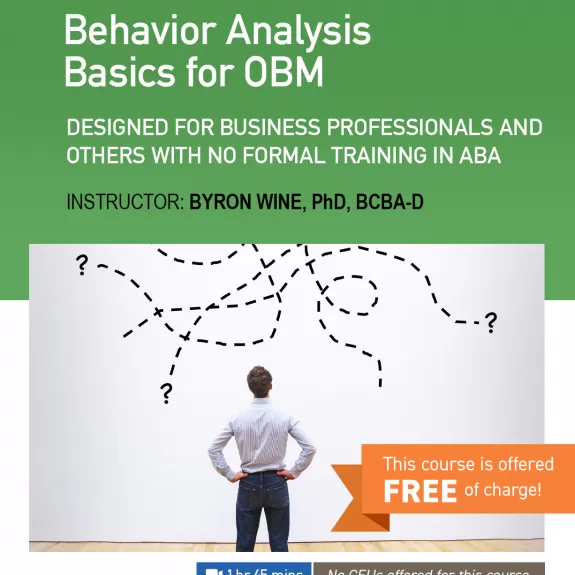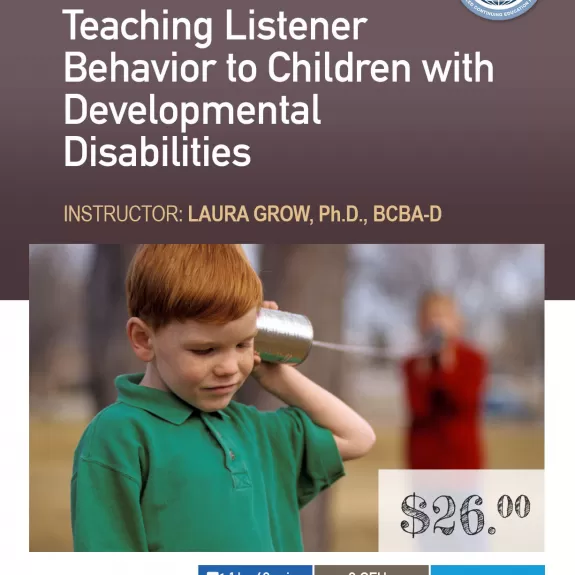Narrow down the results
Feeding Disorders
It is common for those diagnosed with autism to have some type of feeding disorder. Understanding and trying to correct a feeding disorder can be very difficult and time-consuming. Consistent and intensive treatment is most necessary for the treatment of feeding disorders. Henry Roane provides treatment assessment considerations while giving clarity to operational definitions, types of feeding disorders, and evidence-based treatments.
$52.00
Why People Often Make Bad Choices and What to Do about It
Why do people make bad choices? The answer can be found within the schedules of reinforcement that are occurring for that person. Bud Mace provides a refreshing review of all the simple and combined schedules of reinforcement. He further explains different features of combined schedules and how those can be understood through analyzing behavioral results.
$39.00
Applications of Verbal Behavior Language Intervention: How to develop and implement a language intervention program
In Part 4, Dr. Mark Sundberg expands on his previous courses and delves into developing and implementing a language intervention program based on the results of the VB-MAPP Assessments.* Dr. Sundberg overviews typical language development milestones and the implications these have for children and adults with language delays. With the assistance of a completed VB-MAPP, participants will learn the steps to beginning, developing, and implementing an intervention program. Verbal operants will be broken down, and considerations for the selection of goals will be discussed.
$71.50
ICYMI: ABA in Dementia Care- 2014 Literature Review
Approximately 50 million people worldwide are diagnosed with Dementia. According to the World Health Organization (WHO), this number is expected to grow by 10 million new cases every year, which gives Dementia the status of public health and social priority” (WHO, 2016). Given the prevalence of this diagnosis, behavioral research and practice has gained influence over the last decade, focusing on Antecedent manipulation, communication training, satiation, and deprivation.
$32.50
B.F. Skinner's Analysis of Verbal Behavior, Part 2
Verbal behavior is a topic that is most associated with a clinical setting. One of the main targets for clinicians, particularly for early intervention, is teaching mands (likely related to snacks or iPads), tacts, and intraverbals. However, the concepts of verbal behavior are present in everyday interactions and impact how we communicate with others.
$85.00
Using the Law to Secure Health Benefits for Children with Autism
Lawyers frequently must become knowledgeable about science and medicine to present scientific evidence in the courtroom. In this course, join Mr. Kodsi as he discusses the laws surrounding health benefits for children with autism in the state of Florida. This course aims to discuss what Florida health benefits were like prior to the year 2008. Subsequently, Mr. Kodsi then talks about the significance of several cases that have led to the development of present-day Florida laws regarding health benefits for individuals with autism.
$26.00
How to Train, Evaluate and Manage Staff
How many times have you felt the need for better assessing staff or being fairly assessed? Have your expectations always been clearly stated at first? Do leaders have all the right tools to do so? Organizational Behavior Management (OBM) might have some answers. Dr. Byron Wine describes the basis of OBM, its impact on our daily lives, and how to better understand and measure it.
$39.00
Technology and Self-Management for Building Independence
Dr. Newman starts this course by introducing the history of applied behavior analytic principles involved in some self-management strategies that are out there today. In addition to reviewing some history, join Dr. Newman and his colleagues as they take you on a journey of exploring the different processes and methods of self-management.
$19.50
Behavior Analysis Basics for OBM
Behavior analysis? OBM? These are questions you or incoming students of OBM may have. In this course, Dr. Wine gives an overview of behavior analysis, what it is, some of the terminology used, how behavior is measured, and how to increase and decrease certain behaviors. These concepts can be applied to any environment, including organizations, to improve performance.
$0.00
Conditioning the Behavior of the Listener: Implications for Rule-Governed Behavior
Understanding rules and rule-governed behavior has been a pervasive conceptual issue in behavior analysis since Skinner’s initial analysis in his book, Verbal Behavior (1957). Since then the exact function of rules and verbal stimuli has been a point of conjecture. In this course, Dr. Hank Schlinger, BCBA-D, provides a detailed overview of the history of the analysis of rules and provides a contemporary perspective on rule-governed behavior informed by Blakely and Schlinger (1987a, 1987b).
$26.00
It Is Not All about Reinforcement, or Is It? Discriminating between Motivating Operations and Discriminative Stimuli
Reinforcement and its law was a major contributor to the advances made by behavior analysis. However, there is so much more that should be learned regarding contingencies. A better understanding of environmental factors of behavior has aided analysts in analyzing behavior as well as creating treatments for their clients. Antecedent events are just as important as consequences because they directly relate.
$52.00
Language of Emotions
One of the most essential skills children are taught regarding their verbal behavior is communicating their emotions. It may seem that when we first teach an emotion and ways to express it, the client may simply go through the motions. We must take advantage of the contingencies that occur naturally as well as the know-how to create opportunities to teach emotions.
$39.00
Anger and aggression: Foster care population
As Karin Torsiello says, anger and aggression are to be expected in clinical practice and so it is important to learn and address these behaviors in the foster care population. Karin Torsiello discusses the expression of anger and aggression in children, where this may originate, the influence of trauma, and how to treat and manage anger and aggression. This presentation ends by offering tools and activities for providers to use or give to guardians of children to assist in managing anger and aggression.
$32.50
Teaching Listener Behavior to Children with Developmental Disabilities
Listener skills are a primary focus of intervention for individuals with developmental disabilities. In this course, Dr. Laura Grow describes strategies for effectively teaching listener skills with a specific focus on conditional discrimination procedures. Dr. Grow begins this course by defining listener skills and then describes auditory-visual conditional discrimination contingencies as they appear in clinical settings.
$26.00
The Wisdom Factor: Using the Power of Behavior to Shape a Better World
Behavior analytic principles go beyond the standard clinical and organizational behavior change. In this course, Dr. Lattal compares the traditional and behavioral definitions of wisdom, reviews the goals of behavior analysis, and discusses how to teach wisdom. These topics are then combined to define the wisdom factor and how that affects behavior analytic practice.
$19.50














